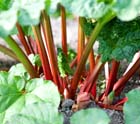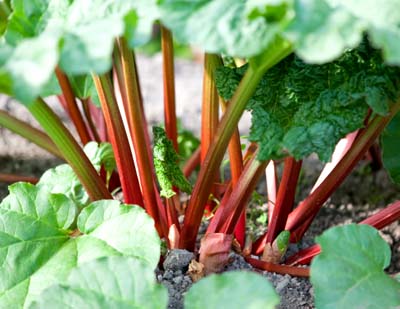Grow rhubarb in your garden
Rhubarb is one of the simplest crops to grow, says Tom Coward


Although it's been a rather damp and windy winter, spring will soon be round the corner and we can start looking forward to the first delicacies of the year from the kitchen garden. Forced rhubarb is one of the finest of these early-season flavours and is especially welcome as one of the few sweets that can be harvested from the garden so early.
Rhubarb is also one of the simplest crops to grow and offers a long cropping season in return for little attention. It can be planted at any time in the dormant months and, once established, will be productive for decades. Our patch at Gravetye is more than 20 years old and continues to supply all our needs from late March to early August each year. The real cream of the crop, however, is the forced stuff and, with a little extra work, these especially tasty sticks can be produced a full three weeks earlier than the main crop.
Rhubarb is forced by being kept in complete darkness as it's coming into growth. In its desperation to get to some light, it will throw up long, thin stems very quickly. These etiolated stems are far less bitter than the main crop and are wonderfully tender, with a sweet, delicate flavour. I like them best lightly poached in a vanilla-and-grenadine syrup, served with ice cream.
The easiest way to force a rhubarb crown is simply to cover it with a large bucket or a big pot with the holes blacked out. At Gravetye, we have some old, purpose-made terracotta forcing pots, which are the perfect size and shape for the job. They make a beautiful feature in the kitchen garden when it's at its most empty and lifting their lids to take a peek inside becomes an obsession as the plants start to come in to growth.
To encourage the plants to crop extra early, the pots can be insulated with a thick mulch of straw. Mounding fresh horse manure over the pots is even more effective, as it gives off heat as it breaks down, warming the rhubarb crown in to growth. Rhubarb responds best after a good period of cold and so it should be exposed to the elements for most of the winter. Mid January to mid Feb- ruary is the best time for placing the forcing pots; then, after about eight weeks (depending on how warm spring is), the delicious pink sticks will be ready to harvest.

All this is a rather unnatural process, putting enormous strain on the plant. It's important to stop harvesting after the first flush, then immediately remove the forcing pot so the poor plant can get some light. To allow the plant to fully recover, it's best not to harvest from it for the rest of the season and not force it again for a few years. For this reason, we rotate our forcing pots through the rhubarb patch each year, ensuring each crown gets a suitable rest as a main crop plant, before taking its turn again in being forced.
For an extra-early crop, rhubarb can be forced indoors. Commercially, it's done by lifting the crowns from the field in winter and bringing them into growth in heated, blacked-out sheds. I thought we might try it this year, so we lifted some crowns from the garden and planted a line in our greenhouse. They were then covered over by a 2ft-high black-plastic tent to exclude the light and I hope to be picking by the end of February.
Sign up for the Country Life Newsletter
Exquisite houses, the beauty of Nature, and how to get the most from your life, straight to your inbox.
Early crops can also be achieved by potting up crowns and forcing them in a dark shed, garage or cellar, where best growth is achieved at about 10˚-15˚C. By the time such plants have finished their harvest, they won't be good for much but the bonfire. The space they leave behind in the rhubarb patch can be quickly filled by dividing some of the neighbouring crowns at the time of lifting. And, in the greenhouse, my rhubarb should vacate the space just in time for us to plant our tomato crop, so the best spring delicacy can make way for us to plant one of the greatest tastes of summer.
* Follow Country Life on Twitter
Country Life is unlike any other magazine: the only glossy weekly on the newsstand and the only magazine that has been guest-edited by HRH The King not once, but twice. It is a celebration of modern rural life and all its diverse joys and pleasures — that was first published in Queen Victoria's Diamond Jubilee year. Our eclectic mixture of witty and informative content — from the most up-to-date property news and commentary and a coveted glimpse inside some of the UK's best houses and gardens, to gardening, the arts and interior design, written by experts in their field — still cannot be found in print or online, anywhere else.
-
 Six rural properties with space, charm and endless views, as seen in Country Life
Six rural properties with space, charm and endless views, as seen in Country LifeWe take a look at some of the best houses to come to the market via Country Life in the past week.
By Toby Keel
-
 Exploring the countryside is essential for our wellbeing, but Right to Roam is going backwards
Exploring the countryside is essential for our wellbeing, but Right to Roam is going backwardsCampaigners in England often point to Scotland as an example of how brilliantly Right to Roam works, but it's not all it's cracked up to be, says Patrick Galbraith.
By Patrick Galbraith